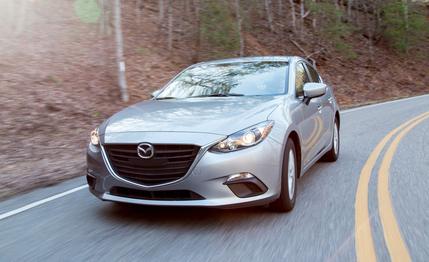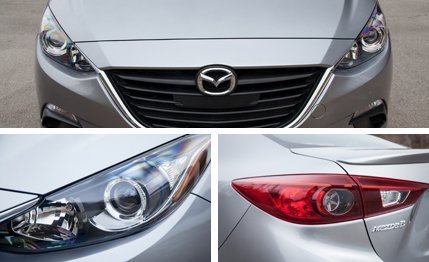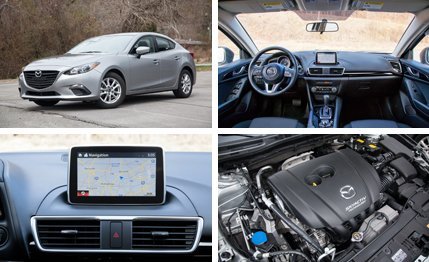
 Instrumented Test
Instrumented Test
Although upstaged somewhat in the 2014 new-car limelight by the sensational Corvette Stingray and glamorous Cadillac CTS, the all-new Mazda 3 rolled into the crowded compact-car sweepstakes as something of a game-changer, achieving top-notch fuel economy without sacrificing driving enjoyment. It also garnered Car and Driver 10Best Cars laurels for 2014.
The key is the company’s Skyactiv technology, which sounds a little mysterious but boils down to improved powertrain efficiency and reduced weight. Both the Mazda 3’s available 2.0- and 2.5-liter four-cylinder engines boast the latest enhancements, including direct fuel injection with a 13.0:1 compression ratio, and the engineering team has painstakingly pared weight in just about every conceivable area—suspension, engines, and transmissions—while beefing up the car’s unitized body structure to handle more-stringent offset frontal collision requirements. Our test car—a Touring sedan with the 2.0-liter engine and six-speed automatic transmission—weighed 2915 pounds. By comparison, the Mazda 3 Touring we tested in 2012—a partially Skyactiv-ated bridge model with a 2.0-liter engine and six-speed manual transmission—weighed 2874 pounds.
This adds up to basically holding the line in terms of mass. That may not sound like headline news, but keep in mind that the National Highway Traffic Safety Administration, abetted by the unofficial but influential Insurance Institute for Highway Safety, is constantly introducing new crash-protection requirements that invariably show up at the scales.
Why all this emphasis on mass? Despite the obvious fuel-economy implications, weight is the implacable enemy in all vehicle dynamics, and power-to-weight is the key to how quickly a car gets across the intersection when the light turns green.


Momentum Factor
Our test car’s 2.0-liter Atkinson cycle DOHC 16-valve four is rated for 155 horsepower and 150 lb-ft of torque, output that we’ve characterized as basically ho-hum in our various encounters. And that description applies to this car’s progress down the block with the throttle wide open.
At the track, the Mazda 3’s speedo needle hit 60 mph in 7.6 seconds, and the compact sedan covered the quarter-mile in 15.9 seconds at 89 mph—about mid-pack versus rival sedans such as the Volkswagen Jetta 1.8T, the Kia Forte 2.0, the Honda Civic 1.8, and the Toyota Corolla 1.8, and far from thrilling. And while the attraction of Mazda’s 2.0-liter engine versus the 2.5-liter option (184 horses, 185 lb-ft) is an edge in fuel economy—30 mpg city, 41 highway for this model, according to the EPA, compared to the 2.5’s 28/39—our 2.0-equipped test car could manage just 29 mpg in 800 miles of admittedly spirited driving.
Still, if the 3’s 2.0-liter engine makes the driver value momentum, the car’s dynamics make momentum exceptionally easy to sustain. This is where the 3 really raises the bar with its limited body motions, athletic transient responses, and electric power steering that’s sports-car quick (2.6 turns lock to lock), accurate, and, unlike so many of the new systems, communicative.
Surprisingly, the new six-speed automatic contributes to the Mazda’s high fun-to-drive score. We still prefer a manual gearbox, particularly when dealing with the limitations of modest power, but the brain governing the 3’s auto-shifter is beautifully programmed to keep the engine at optimum rpm. Shifts are smooth, up or down, and the responses to throttle demands are right-now prompt. Manual shifting can be achieved by toggling the shifter fore and aft, and the response times using this method are above average. But most automatics in this class are driven in automatic mode most of the time, and assessed on that basis, the Mazda 3’s six-speed gets high marks.
Our test car was equipped with a set of 205/60-16 Yokohama Avid BluEarth low-rolling-resistance all-season tires. Chosen for fuel-economy optimization, they probably held the 3 back in dynamic scoring, although their tall sidewalls likely helped to smooth ride quality. With that indifferent rubber in mind, 0.82 g on the skidpad—tires howling in protest—looks like a pretty good result. So does a 167-foot braking distance from 70 mph, a tribute to the Mazda’s system—one that’s easy to modulate and with excellent pedal feel.


The Eyes, Ears, and Backside Report
While dynamics put the 3 at the top of the compact heap, Mazda hasn’t neglected the niceties. Interior materials exude quality—even in the mid-level Touring model we tested, the front seats are well bolstered and the comfort levels are high. Standard equipment is comprehensive, with a long list of safety features that includes blind-spot monitoring and rear cross-traffic-alert systems. The design team has achieved something few others have managed—a practical compact sedan that actually looks good.
As tested, our $23,235 Mazda 3 i 2.0 Touring sedan was equipped with the $1600 Technology package, which includes navigation, a seven-inch color touch screen, nine-speaker Bose audio, satellite radio, a rearview camera, two USB ports, dual-zone climate control, and text message audio delivery and reply. The base price for the 2.0 Touring automatic is $21,440.
The Mazda 3 Touring is competitively priced, although far from the least expensive among economy-oriented compact cars. (The 2.0 auto combo is also available in the $18,790 SV and the $20,290 Sport.) But that leaves out an important intangible. What price do you set on a rewarding experience behind the wheel? Factor that number in, and the Mazda 3 is tough to beat.